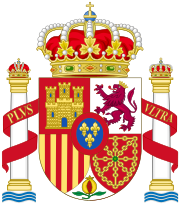Portal:Castile
The Spain PortalSpain (Spanish: España, [esˈpaɲa] ( With an area of 505,990 km2 (195,360 sq mi), Spain is the largest country in Southern Europe, the second-largest country in Western Europe and the European Union, and the fourth-largest country by area on the European continent. With a population exceeding 47.3 million, Spain is the sixth-most populous country in Europe, and the fourth-most populous country in the European Union. Spain's capital and largest city is Madrid; other major urban areas include Barcelona, Valencia, Seville, Zaragoza, Málaga, and Bilbao. Modern humans first arrived in the Iberian Peninsula around 35,000 years ago. Iberian cultures along with ancient Phoenician, Greek, Celtic and Carthaginian settlements developed on the peninsula until it came under Roman rule around 200 BCE, after which the region was named Hispania, based on the earlier Phoenician name Sp(a)n or Spania. At the end of the Western Roman Empire, Germanic tribal confederations migrated from Central Europe, invaded the Iberian peninsula and established relatively independent realms in its western provinces. One of them, the Visigoths, forcibly integrated all remaining independent territories in the peninsula, including the Byzantine province of Spania, into the Visigothic Kingdom. This is a Featured article, which represents some of the best content on English Wikipedia..
The Colossus of Rhodes is a 1954 oil painting by the Spanish surrealist artist Salvador Dalí. It is one of a series of seven paintings created for the 1956 film Seven Wonders of the World, each depicting one of the eponymous wonders. The painting shows the Colossus of Rhodes, the ancient statue of the Greek titan-god of the sun, Helios. It was ultimately not used for the movie, and in 1981 was donated to the Kunstmuseum Bern, its present location. Painted two decades after Dalí's heyday with the surrealist movement, The Colossus of Rhodes is emblematic of his shift from the avant-garde to the mainstream. After financial pressures imposed by his move to the United States in 1940, and influenced by his fascination with Hollywood, Dalí shifted focus away from his earlier exploration of the subconscious and perception, and towards historical and scientific themes. Read more...Selected article -Galicia (/ɡəˈlɪʃ(i)ə/; Galician: Galicia [ɡaˈliθjɐ] or Galiza [ɡaˈliθɐ]; Spanish: Galicia) is an autonomous community of Spain and historic nationality under Spanish law. Located in the northwest Iberian Peninsula, it includes the provinces of A Coruña, Lugo, Ourense and Pontevedra. Galicia is bordered by Portugal to the south, the Spanish autonomous communities of Castile and León and Asturias to the east, the Atlantic Ocean to the west, and the Cantabrian Sea to the north. It had a population of 2,701,743 in 2018 and a total area of 29,574 km2 (11,419 sq mi). Galicia has over 1,660 km (1,030 mi) of coastline, including its offshore islands and islets, among them Cíes Islands, Ons, Sálvora, Cortegada, and the largest and most populated, A Illa de Arousa. Read more...This is a Good article, an article that meets a core set of high editorial standards.
Erromintxela (Basque pronunciation: [eromintʃela] ( Selected biographyAntoni Plàcid Guillem Gaudí i Cornet (25 June 1852 – Barcelona, 10 June 1926) – sometimes referred to by the Spanish form of his name, Antonio Gaudí – was a Spanish Catalan architect, who belonged to the Modernisme (Art Nouveau) movement and was famous for his unique style and highly individualistic designs. Gaudí was born in the province of Tarragona in southern Catalonia, Spain in 1852. While there is some dispute as to his birthplace – official documents state that he was born in the town of Reus, whereas others claim he was born in Riudoms, a small village 3 miles (5 km) from Reus. Gaudí, as an architecture student at the Escola Tècnica Superior d'Arquitectura in Barcelona from 1873 to 1877, achieved only mediocre grades but did well in his "Trial drawings and projects." After five years of work, he was awarded the title of architect in 1878. As he signed Gaudí's title, Elies Rogent declared, "Qui sap si hem donat el diploma a un boig o a un geni: el temps ens ho dirà" ("Who knows whether we have given this diploma to a nut or to a genius. Time will tell.") The newly named architect immediately began to plan and design and would remain affiliated with the school his entire life. Gaudí's first works were designed in the style of gothic and traditional Spanish architectural modes, but he soon developed his own distinct sculptural style. French architect Eugene Viollet-le-Duc, who promoted an evolved form of gothic architecture, proved a major influence on Gaudí. But the student surpassed the master architect and contrived highly original designs – irregular and fantastically intricate. Some of his greatest works, most notably La Sagrada Família, have an almost hallucinatory power. Selected pictureThe Barcelona Free Port or Zona franca de Barcelona is a tariff-free industrial park that has developed within the Port of Barcelona, across the flat land of the Llobregat delta between the city of Barcelona and Barcelona International Airport to the south. General imagesDid you know...
In the news
Spain topicsRecognized content
Featured articles
Good articles
Featured picturesWikiProjects
WikiProject Basque • WikiProject Catalan-speaking Countries • WikiProject Galicia • Spanish Translation of the Week CategoriesThings you can do
Related portalsAssociated WikimediaPortals |
This page was last updated at 2020-08-15 17:01 UTC. Update now. View original page.
All our content comes from Wikipedia and under the Creative Commons Attribution-ShareAlike License.






























































